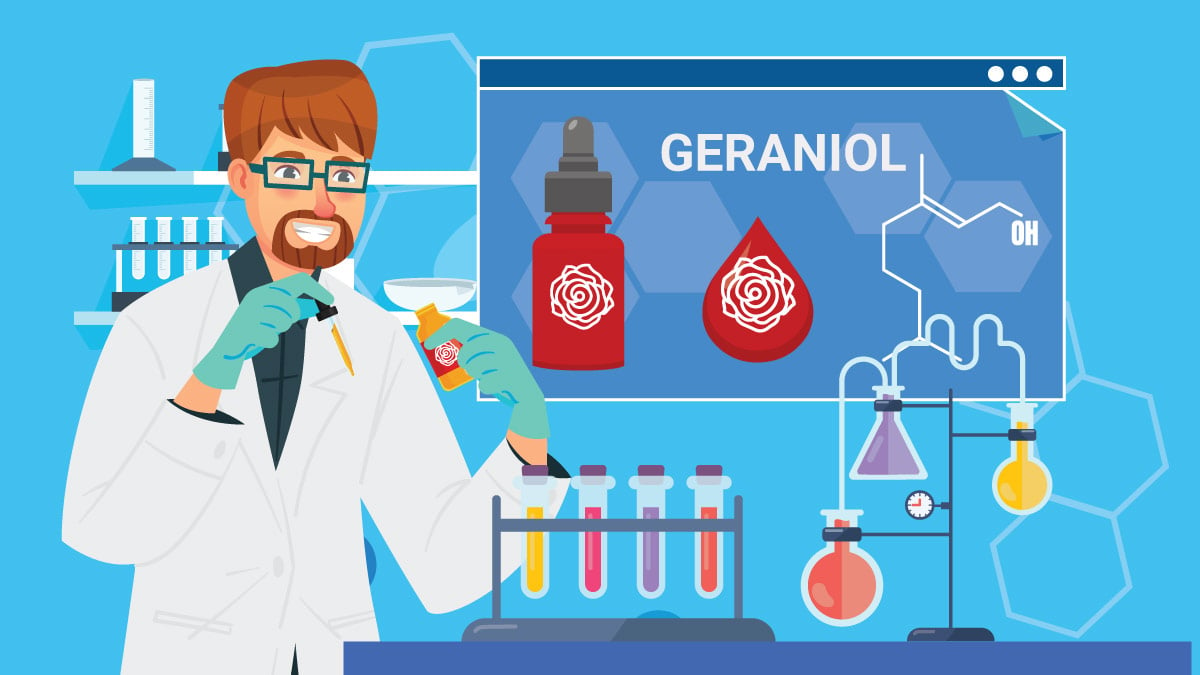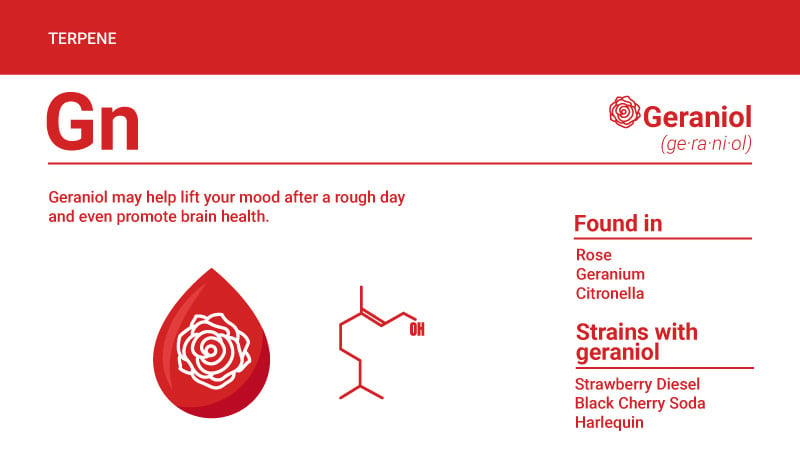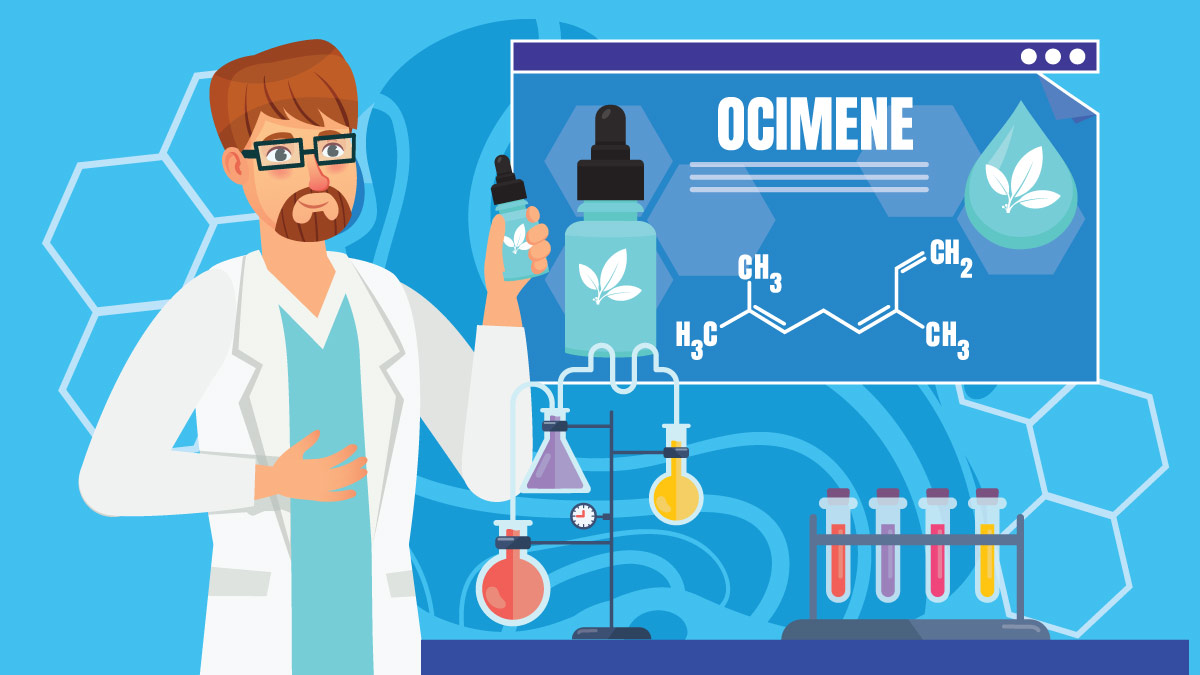Geraniol Terpene: Strains, Effects, Benefits, and More

Geraniol — also known as lemonol, guainol, and beta-geraniol — is a pale yellow or colorless oily terpenoid.
This compound is characterized by its sweet and fragrant rose and general floral odor profile.
This compound was named after the first plant it was discovered in — geranium. It’s since been found in over a dozen other species of plants, including cannabis.
Here, we’ll cover everything you need to know about geraniol and what current research says about this unique terpene.
What is Geraniol?
Geraniol is fragrant terpene alcohol with a distinct floral aroma. If you’ve ever smelled geranium or rose you’ll be familiar with the aroma of geraniol.
Experts believe the main reason plants produce geraniol is to attract pollinators.
In fact, one study found that bees produce geraniol in their scent glands and use it to mark nectar-bearing flowers and locate the entrances to their hives. It’s possible that some species of plants produce their own geraniol in order to attract this important pollinator.
Related: What Are Terpenes?
What Does Geraniol Smell Like?
Geraniol takes on a rose-like, sweet, floral aroma. The flavor is similar to the smell, except with notable hints of fruit or citrus. It also has a waxy-flavored undertone.
How Do You Pronounce Geraniol?
Geraniol is pronounced “ger-ain-ee-ole.”
What are the Effects of Geraniol?
Geraniol and the plants it’s derived from have a long history of use in traditional and herbal medicines — but there are few studies exploring the specific benefits of this terpene on its own.
The most common traditional applications for plants containing geraniol include inflammatory conditions, mood disorders, neurological deficits, and chronic pain.
The effects of this terpene are best described as “uplifting.” This terpene is usually found in flowers.
The scent is highly connected with the limbic system, which is involved in regulating much of our mood and memories. Floral terpenes like geraniol most often correlate with positive memories and experiences that have an indirect but powerful impact on our current mood.
Is Geraniol Safe?
According to the US Food and Drug Administration, geraniol is considered safe for human consumption.
However, like any terpene, it needs to be diluted prior to use. Pure, concentrated geraniol can be harmful to the skin, eyes, and lungs if used improperly. Always dilute your terpenes to 5% or less.
Learn More: Are Terpenes Safe?
Geraniol Research
There hasn’t been much research on this terpene to date, and most of what’s available so far are from in vitro or animal studies.
While this type of research has its benefits, it’s hard to directly correlate the results to any specific benefits in humans.
With that said, here’s what research is available so far for the effects of geraniol:
Geraniol has been found to exert a protective role in rodents with SCI (spinal cord injuries) by “inhibiting the inflammatory response, oxidative stress, and apoptosis, thereby promoting functional recovery through downregulation of NF-κB and p38 MAPK in SCI rats”.
Another recent study found that Geraniol significantly decreased the concentrations of inflammatory cytokines and oxidative stress factors in MRSA-infected mice.
Geraniol has been shown to mitigate diabetic neuropathy associated with oxidative/nitrosative stress in diabetic rats. Rats that were given 100mg/kg per day for eight weeks showed significant improvement in both sensory and motor function.
A study all the way back in 1997 showed that of 5 essential oils tested (cineole, citral, geraniol, linalool, and menthol). Geraniol was the most effective antifungal — inhibiting all 12 fungi tested. It was also the second most effective antibacterial — inhibiting 16 of 18 bacteria tested.
Geraniol treatment was found to increase anti-oxidative defenses in mice liver, with no signs of liver toxicity. The study found that geraniol increased hepatic CAT, NQO1, SOD enzymatic activity (antioxidant mechanisms).
One study found geraniol increased barbiturate-induced sleeping time and increased the percentage of theta waves (ultra-slow and delta) in rats.
Lastly, a study from 2021 observed the antioxidant effects of geraniol on memory impairment and neurotoxicity in rodents.
Plants (& Other Natural Sources) That Contain Geraniol
Geraniol is found in many species of plants, here are just a few of the most abundant sources:
- Rose
- Geranium
- Cannabis
- Honey bees
- Citronella
- Thyme
- Helichrysum
- Neroli
- Palmarosas
What Cannabis Strains Contain Geraniol?
Geraniol is common in cannabis but rarely takes center stage. Most of the time, this terpene is found in concentrations below 0.1%, but there are a few exceptions.
Cannabis strains high in geraniol:
- Amnesia Haze
- Afghani
- Master Kush
- Black Cherry Soda
- Harlequin
- Agent Orange
- Strawberry Diesel
- Dutch Hawaiian
Related: Which Terpenes Are Found In Cannabis?
Chemical Structure of Geraniol
Geraniol is classified as a monoterpenoid. Its terpene alcohol (ends with -ol) is closely related to borneol, camphene, citral, P-cymene, delta-3-carene, eucalyptol, fenchol, isopulegol, limonene, linalool, myrcene, ocimene, pinene, phellandrene, sabinene, terpineol, terpinolene, and many others.
There exists a non-alcohol geraniol derivative called geranyl-acetate — but this isomer is much less common in plants.
Geraniol Specs:
- IUPAC Name: (2E)-3,7-dimethylocta-2,6-dien-1-ol
- Molecular Formula: C10H16
- Molecular Weight: 154.253
- Boiling Point: 230°C (446ºF)
Does Geraniol Get You High?
No, geraniol is non-psychoactive.
In fact, most terpenes, with the exception of myristicin and salvinorin A are completely non-psychoactive — at least in the traditional sense.
Anecdotal reports suggest geraniol may be euphoric — offering potent but very short-lived euphoria by interacting with the limbic system in the brain. This effect has not been confirmed in scientific research.
Related: Will Terpenes Make Me High?
Key Takeaways: What is Geraniol?
Geraniol is a powerful compound that has a large range of uses. It is found in many plants as well as honey bees. It can be found in food products, skincare, and cosmetics.
We offer several terpene blends that feature geraniol, including Harlequin and Agent Orange.
References Cited
- Wang, J., Su, B., Zhu, H., Chen, C., & Zhao, G. (2016). The protective effect of geraniol inhibits inflammatory response, oxidative stress, and apoptosis in the traumatic injury of the spinal cord through modulation of NF-κB and p38 MAPK. Experimental and therapeutic medicine, 12(6), 3607–3613. https://doi.org/10.3892/etm.2016.3850
- Prasad, S.N. and Muralidhara, (2014), Protective effects of geraniol (a monoterpene) in a diabetic neuropathy rat model: Attenuation of behavioral impairments and biochemical perturbations. Journal of Neuroscience Research, 92: 1205-1216. https://doi.org/10.1002/jnr.23393
- Pattnaik, S., Subramanyam, V. R., Bapaji, M., & Kole, C. R. (1997). Antibacterial and antifungal activity of aromatic constituents of essential oils. Microbios, 89(358), 39–46.
- Cho, M., So, I., Chun, J.N., & Jeon, J. (2016). The antitumor effects of geraniol: Modulation of cancer hallmark pathways (Review). International Journal of Oncology, 48, 1772-1782. https://doi.org/10.3892/ijo.2016.3427
- Chirumbolo, S. and Bjørklund, G. (2017), The Antinociceptive Activity of Geraniol. Basic Clin Pharmacol Toxicol, 120: 105-107. https://doi.org/10.1111/bcpt.12683
- Pavan, B., Dalpiaz, A., Marani, L., Beggiato, S., Ferraro, L., Canistro, D., Paolini, M., Vivarelli, F., Valerii, M. C., Comparone, A., De Fazio, L., & Spisni, E. (2018). Geraniol Pharmacokinetics, Bioavailability and Its Multiple Effects on the Liver Antioxidant and Xenobiotic-Metabolizing Enzymes. Frontiers in pharmacology, 9, 18. https://doi.org/10.3389/fphar.2018.00018
- Medeiros, K., Dos Santos, J. R., Melo, T., de Souza, M. F., Santos, L. G., de Gois, A. M., Cintra, R. R., Lins, L., Ribeiro, A. M., & Marchioro, M. (2018). Depressant effect of geraniol on the central nervous system of rats: Behavior and ECoG power spectra. Biomedical journal, 41(5), 298–305. https://doi.org/10.1016/j.bj.2018.08.008
- Danka, R. G., Williams, J. L., & Rinderer, T. E. (1990). A bait station for survey and detection of honey bees. Apidologie, 21(4), 287-292.
- Wang, J., Su, B., Zhu, H., Chen, C., & Zhao, G. (2016). The protective effect of geraniol inhibits inflammatory response, oxidative stress, and apoptosis in the traumatic injury of the spinal cord through modulation of NF-κB and p38 MAPK. Experimental and therapeutic medicine, 12(6), 3607–3613. https://doi.org/10.3892/etm.2016.3850 [9]
- Lin, L., Long, N., Qiu, M., Liu, Y., Sun, F., & Dai, M. (2021). The Inhibitory Efficiencies of Geraniol as an Anti-Inflammatory, Antioxidant, and Antibacterial, Natural Agent Against Methicillin-Resistant Staphylococcus aureus Infection in vivo. Infection and Drug Resistance, 14, 2991. [10]
- Prasad, S. N. (2014). Protective effects of geraniol (a monoterpene) in a diabetic neuropathy rat model: attenuation of behavioral impairments and biochemical perturbations. Journal of neuroscience research, 92(9), 1205-1216.
- Pattnaik, S., Subramanyam, V. R., Bapaji, M., & Kole, C. R. (1997). Antibacterial and antifungal activity of aromatic constituents of essential oils. Microbios, 89(358), 39–46.
- ChO, M. I. N. S. O. O., So, I., Chun, J. N., & Jeon, J. H. (2016). The antitumor effects of geraniol: Modulation of cancer hallmark pathways. International journal of oncology, 48(5), 1772-1782.
- Chirumbolo, S. and Bjørklund, G. (2017), The Antinociceptive Activity of Geraniol. Basic Clin Pharmacol Toxicol, 120: 105-107. https://doi.org/10.1111/bcpt.12683
- Yan Lv, Liang Zhang, Na Li, Naiken Mai, Yu Zhang, Shuyi Pan, Canadian Journal of Physiology and Pharmacology, 23 March 2017, https://doi.org/10.1139/cjpp-2016-0528
- Pavan, B., Dalpiaz, A., Marani, L., Beggiato, S., Ferraro, L., Canistro, D., Paolini, M., Vivarelli, F., Valerii, M. C., Comparone, A., De Fazio, L., & Spisni, E. (2018). Geraniol Pharmacokinetics, Bioavailability and Its Multiple Effects on the Liver Antioxidant and Xenobiotic-Metabolizing Enzymes. Frontiers in pharmacology, 9, 18. https://doi.org/10.3389/fphar.2018.00018 [16]
- Medeiros, K., Dos Santos, J. R., Melo, T., de Souza, M. F., Santos, L. G., de Gois, A. M., Cintra, R. R., Lins, L., Ribeiro, A. M., & Marchioro, M. (2018). Depressant effect of geraniol on the central nervous system of rats: Behavior and ECoG power spectra. Biomedical journal, 41(5), 298–305. https://doi.org/10.1016/j.bj.2018.08.008
- Deng, X. Y., Xue, J. S., Li, H. Y., Ma, Z. Q., Fu, Q., Qu, R., & Ma, S. P. (2015). Geraniol produces antidepressant-like effects in a chronic unpredictable mild stress mice model. Physiology & behavior, 152, 264-271.
- Chaudhary, S.C., Siddiqui, M.S., Athar, M., and Alam, M.S. (2013), Geraniol inhibits murine skin tumorigenesis by modulating COX-2 expression, Ras-ERK1/2 signaling pathway, and apoptosis. J. Appl. Toxicol., 33: 828-837. https://doi.org/10.1002/jat.2739
- Farokhcheh, M., Hejazian, L., Akbarnejad, Z., Pourabdolhossein, F., Hosseini, S. M., Mehraei, T. M., & Soltanpour, N. (2021). Geraniol improved memory impairment and neurotoxicity induced by zinc oxide nanoparticles in male wistar rats through its antioxidant effect. Life Sciences, 282, 119823.
- Farokhcheh, M., Hejazian, L., Akbarnejad, Z., Pourabdolhossein, F., Hosseini, S. M., Mehraei, T. M., & Soltanpour, N. (2021). Geraniol improved memory impairment and neurotoxicity induced by zinc oxide nanoparticles in male wistar rats through its antioxidant effect. Life Sciences, 282, 119823.


